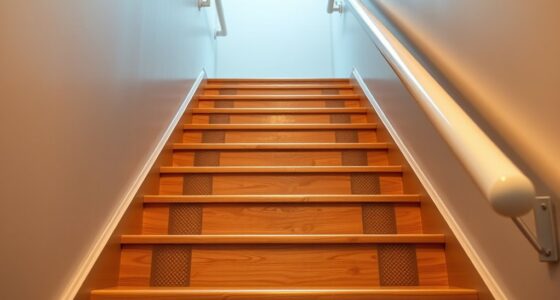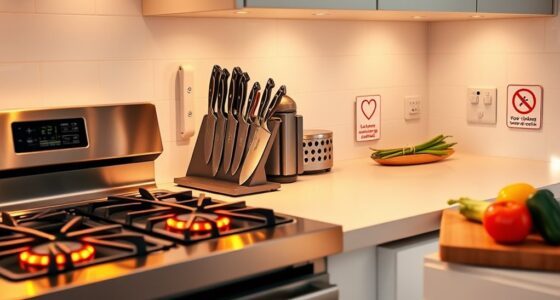A home safety audit involves checking each room for hazards and making improvements to prevent accidents. In your kitchen, guarantee appliances are in good shape and outlets aren’t overloaded. In the living room, keep cords, furniture, and decorations secure. Bedrooms should have sturdy furniture and working smoke detectors. Bathrooms need slip-resistant surfaces and water temperature controls. Don’t forget to assess your garage and outdoor areas for clutter and hazards. Continuing will help you uncover more tips for a safer home.
Key Takeaways
- Conduct room-specific safety checks for appliances, furniture stability, and hazards in each area of the home.
- Inspect outdoor spaces and yard for fences, lighting, debris, and potential trip hazards.
- Ensure proper storage and labeling of chemicals and tools to prevent accidents.
- Install safety devices like smoke detectors, slip-resistant mats, and nightlights throughout the home.
- Regularly review and update safety measures based on current conditions and resource awareness.
Kitchen Safety Checks
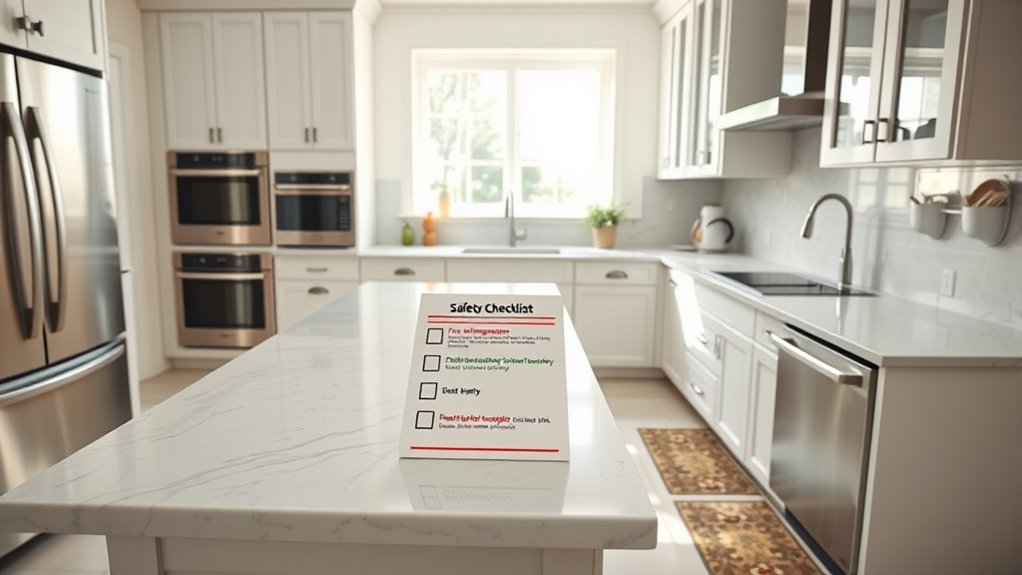
To keep your kitchen safe, start by inspecting your appliances and wiring. Proper appliance placement is vital to prevent accidents and reduce fire hazards. Keep appliances away from water sources like sinks and make certain cords aren’t stretched across walkways. Avoid overloading outlets, which can overheat and cause fires. Check that your stove, microwave, and refrigerator are in good condition, with no frayed wires or loose plugs. Clear clutter around appliances to prevent accidental tipping or fires. Make sure ventilation is adequate, especially when using high-heat devices. Regularly clean behind appliances to prevent dust buildup that could ignite. Additionally, understanding fire safety measures can help you respond effectively in emergencies. By maintaining proper appliance placement and addressing potential fire hazards, you create a safer kitchen environment for everyone.
Living Room Safety Tips
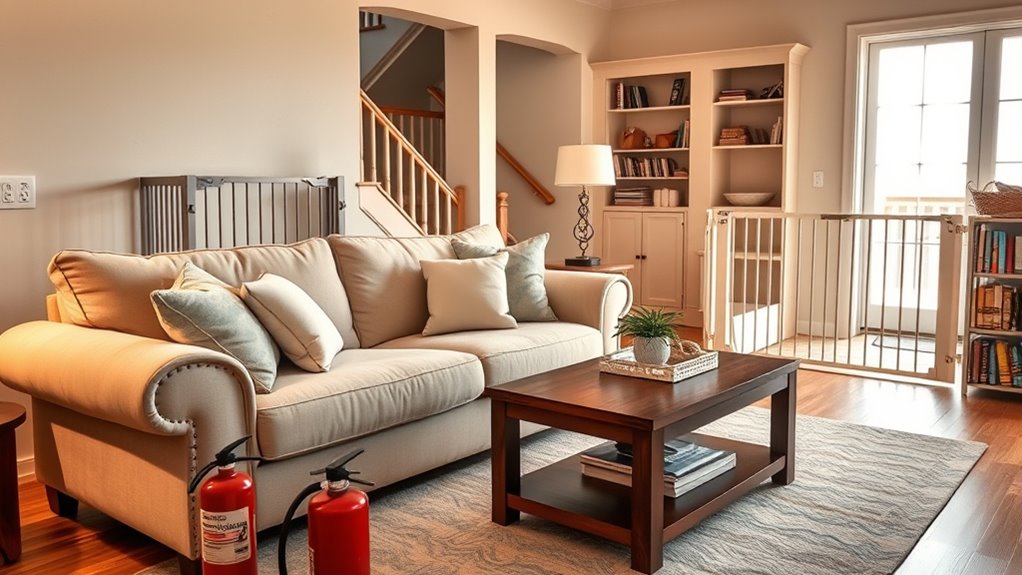
Since the living room is a common gathering space, guaranteeing its safety is essential. Start by checking for fire hazards, such as placing candles, heaters, or electronics away from curtains and furniture. Never overload electrical outlets, and unplug devices when not in use. Focus on furniture stability; ensure all pieces are sturdy and anchored if needed, especially if you have children or pets. Avoid placing heavy items on high shelves that could fall. Keep walkways clear of clutter to prevent tripping. Regularly inspect cords and wires for damage, replacing any frayed or damaged ones immediately. Properly ventilate the space to avoid smoke buildup in case of a fire. These steps help create a safer living environment for everyone.
Bedroom Safety Measures
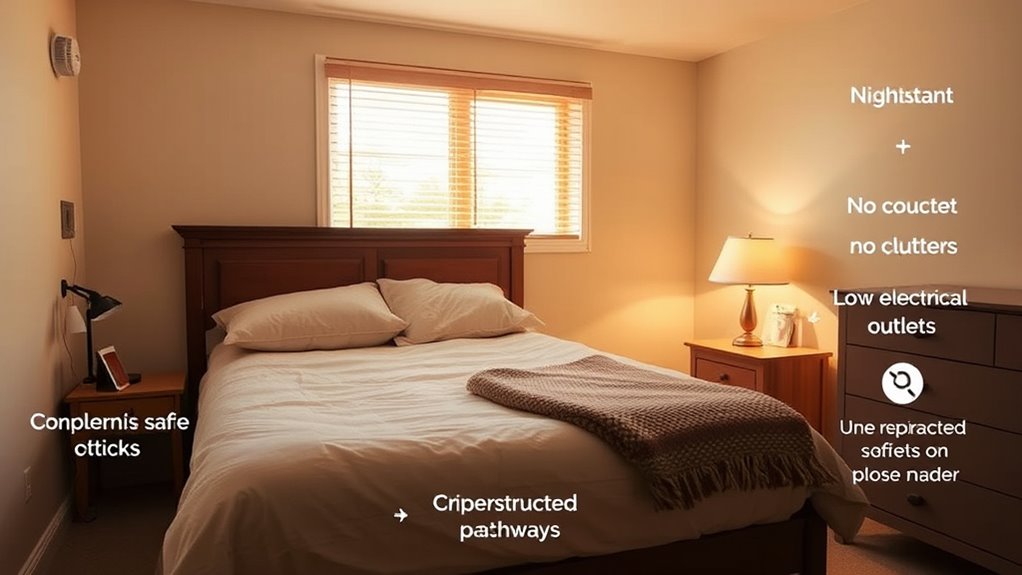
Creating a safe bedroom environment helps prevent accidents and provides peace of mind. Start by identifying common bedroom hazards, such as loose rugs, clutter, or unstable furniture, which can cause falls. Ensure your sleep safety by keeping pathways clear and avoiding cords near the bed. Proper lighting is essential, especially at night, to prevent trips. Secure heavy furniture to the wall to avoid tipping. Use smoke detectors and keep a fire extinguisher nearby. Regularly check for hazards like broken slats or sharp edges. Here’s a quick safety overview:
| Hazard | Prevention | Notes |
|---|---|---|
| Loose rugs | Secure with non-slip pads | Prevent trips |
| Clutter | Keep pathways clear | Avoid falls |
| Unstable furniture | Anchor to wall | Prevent tipping |
| Poor lighting | Install nightlights | Improve sleep safety |
Additionally, practicing mindfulness can help you stay alert to potential hazards and maintain a safe environment.
Bathroom Safety Precautions
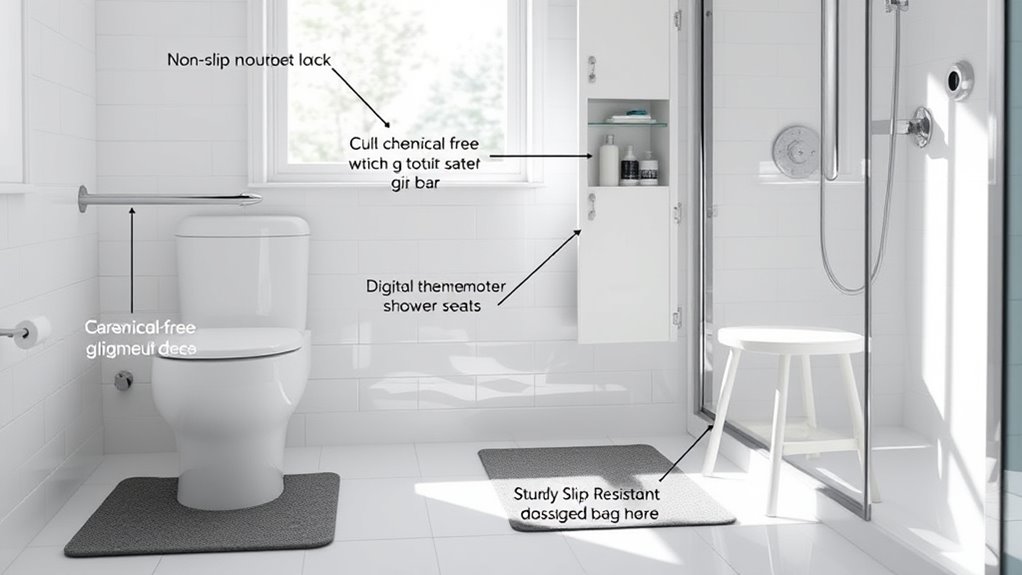
To keep your bathroom safe, start by installing slip-resistant surfaces on the floor to prevent falls. Make sure water temperature controls are easy to adjust and set to a safe level to avoid burns. Adequate lighting is essential so you can see clearly and avoid accidents when using the space.
Slip-Resistant Surfaces
Are your bathroom floors safe to walk on, especially when they’re wet? Non slip flooring is essential to prevent falls and injuries. Consider installing textured surfaces or adding non-slip mats in high-risk areas like the shower and near the sink. These textured surfaces provide better grip, reducing the likelihood of slipping when the floor is damp. Make sure existing tiles are slip-resistant; if not, replace them with safer options. Regularly clean and dry the floor to eliminate soap scum and water buildup that can cause slips. Installing grab bars and ensuring ample lighting also enhance safety. Taking these precautions keeps your bathroom a safer space for everyone, especially those with mobility issues or balance concerns. Employing effective email marketing strategies like targeted messaging can also educate family members on safety practices.
Water Temperature Controls
Since hot water can cause burns or scalds, it’s important to set your water heater to a safe temperature, ideally around 120°F (49°C). Adjusting water temperature is a simple yet essential step in bathroom safety. Check your water heater’s thermostat regularly to confirm it stays at this safe level. Proper water heater safety prevents accidental burns, especially for children and older adults. Consider installing anti-scald devices or mixing valves to automatically limit water temperature at faucets and showerheads. Always test the water temperature before use, and educate all household members about the importance of maintaining safe water settings. Regularly maintaining your water heater and adjusting the temperature as needed can substantially reduce the risk of scald injuries in your home. Being aware of water temperature controls can help you better protect your household from preventable injuries.
Adequate Lighting
Ensuring your bathroom is well-lit reduces the risk of accidents and injuries. Poor lighting can create lighting hazards, making it difficult to see obstacles or wet surfaces clearly. To improve safety, check bulb placement—make sure fixtures are positioned to provide even illumination without shadows or dark spots. Use bright, energy-efficient bulbs that mimic natural light to enhance visibility. Avoid placing bulbs directly over mirrors or sinks, as glare can impair your vision. Install nightlights or motion-activated lighting for nighttime use, reducing the chance of slips or falls in the dark. Regularly replace burnt-out bulbs promptly to maintain consistent lighting. Proper lighting not only enhances safety but also creates a more comfortable and functional bathroom environment. Additionally, consider lighting safety standards to ensure your bathroom meets recommended guidelines for optimal illumination.
Children’s Room Safety Guidelines

Creating a safe environment in your child’s room is essential for preventing accidents and promoting peace of mind. You should prioritize secure toy storage to keep clutter off the floor and reduce tripping hazards. Ensuring furniture is properly anchoring prevents tipping over if your child pulls or climbs on it. Regularly check for small parts or choking hazards in toys and remove any broken or unsafe items. Keep cords and window blind chains out of reach to prevent strangulation risks. Additionally, use outlet covers to protect against electrical shocks. These safety measures create a safer space and help you feel confident that your child is protected. Remember, a proactive approach minimizes hazards and supports your child’s curiosity and independence. Incorporating automation technologies in safety monitoring can further enhance your ability to detect potential dangers in real-time.
Garage and Storage Area Safety

Keeping your garage organized reduces the risk of accidents and makes it easier to find what you need. Store tools and chemicals securely out of reach of children and pets. Regularly check for hazards to guarantee your garage remains a safe space for everyone. Implementing a maintenance routine can help identify potential dangers early and ensure ongoing safety.
Garage Organization Tips
A well-organized garage not only makes it easier to find tools and equipment but also substantially reduces safety hazards. Clearing garage clutter prevents tripping and falling, creating a safer environment. Invest in effective storage solutions like wall-mounted racks, pegboards, and labeled bins to keep items off the floor. Properly storing heavy items at waist level minimizes injury risk when lifting. Keep frequently used tools within reach and store hazardous materials separately. Regularly declutter to prevent accumulation of unnecessary items that can block exits or create fire hazards. Consider installing ceiling hooks for seasonal items and using clear, stackable containers for easy identification. An organized garage enhances safety, maximizes space, and keeps your belongings accessible and secure. Additionally, understanding the AI Bifurcation in technology can help you stay informed about future innovations that might influence home safety devices and automation.
Tool and Chemical Safety
Have you properly stored and labeled your tools and chemicals to prevent accidents? Good chemical storage is essential—keep hazardous substances in locked cabinets, away from children and pets. Ensure chemicals are clearly labeled with contents and safety warnings. Regular tool maintenance is key; inspect tools for damage and repair or replace as needed to avoid malfunctions. Store tools in designated areas, organized for quick access, and keep sharp or heavy tools separate from lighter items. Proper chemical storage and tool maintenance reduce the risk of spills, leaks, or injuries. Additionally, understanding the horsepower of your electric dirt bikes can help you select the right model for your riding needs. Always follow manufacturer instructions for chemicals, and dispose of expired or unused substances safely. Taking these steps helps create a safer garage environment, preventing mishaps and promoting responsible storage habits.
Outdoors and Yard Safety Inspection
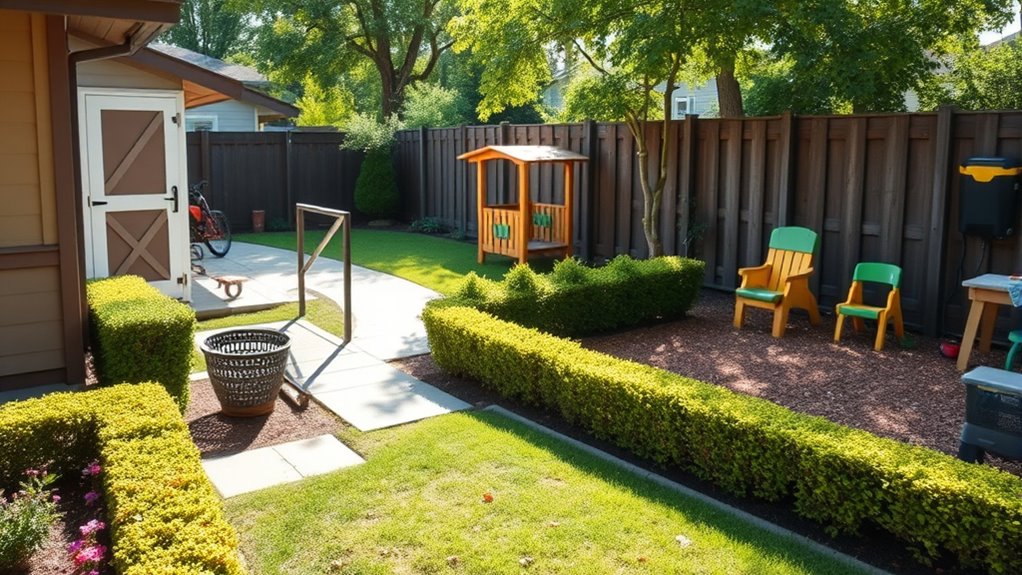
Ensuring your yard and outdoor spaces are safe is an essential step in preventing accidents and injuries. Start by inspecting fences to guarantee fencing integrity, preventing wildlife encounters that could pose risks. Check for broken or loose panels, and repair or replace damaged sections promptly. Trim overgrown bushes and trees to eliminate hiding spots for pests or unwanted animals. Remove any debris, tools, or hazardous items that could cause trips or falls. Make sure gates latch securely to prevent children or pets from wandering off unsupervised. Regularly review outdoor lighting to guarantee pathways are well-lit at night. Conducting a home safety audit helps identify potential hazards and maintain a secure outdoor environment. These steps help keep your yard safe, reducing the chance of accidents and wildlife surprises, and creating a secure outdoor environment for everyone.
Frequently Asked Questions
How Often Should I Perform a Home Safety Audit?
You should perform a home safety audit at least once a year to guarantee fire prevention measures are up-to-date and your emergency preparedness plan is effective. Regular checks help identify hazards like faulty wiring or blocked exits. By staying proactive, you minimize risks and create a safer environment for everyone. Don’t forget to review fire extinguishers, smoke detectors, and escape routes during each audit to stay fully prepared.
What Tools Are Recommended for Conducting a Thorough Safety Check?
You need the right tools to get the job done right. Grab safety equipment like gloves, goggles, and a dust mask for protection. Use inspection tools such as a flashlight, ladder, and a smoke detector tester to thoroughly check each room. Having a handy screwdriver or level helps identify hazards and ensure everything’s secure. These tools help you spot dangers early and keep your home safe—don’t let safety slip through the cracks.
How Can I Involve Family Members in Safety Assessments?
You can involve family members in safety assessments by encouraging open family communication, making sure everyone understands potential hazards. Assign shared responsibilities, like checking fire alarms or securing furniture, to foster teamwork. Hold regular safety meetings to discuss concerns and updates, ensuring everyone stays informed and engaged. By actively involving your family, you create a safer home environment and promote collective responsibility for ongoing safety.
What Are Common Safety Hazards Often Overlooked in Home Audits?
You might be surprised to find that fire hazards and electrical risks are often overlooked during home audits. People tend to focus on obvious dangers, missing hazards like overloaded outlets or unattended candles. Always check for frayed wires, proper smoke detectors, and clear escape routes. Regularly inspecting these areas helps prevent accidents. Don’t forget to test your fire alarms and keep flammable items away from heat sources to guarantee safety.
When Should I Hire Professional Help for Home Safety Inspections?
You should hire a professional inspection or safety consultation when you notice persistent hazards, lack of expertise, or recent changes in your home. If you’re unsure about electrical systems, structural integrity, or fire safety, a professional can identify hidden risks. They bring specialized tools and knowledge to guarantee your home is safe. Don’t hesitate to seek expert help if you want peace of mind and thorough safety assessments.
Conclusion
Remember, safety starts at home, and a little caution goes a long way. By taking these room-by-room steps, you’re creating a safer environment for everyone. Regular checks may seem small, but they add up to big peace of mind. Don’t wait for an accident to remind you—an ounce of prevention is worth a pound of cure. Stay vigilant, stay safe, and turn your home into a haven where everyone can thrive.


